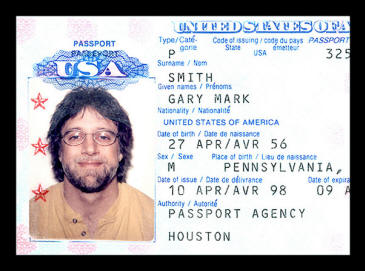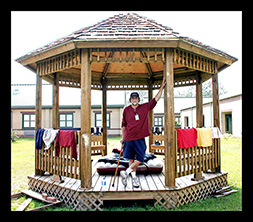Artist Biography
** Art About everyday life in the civilized world’s most frightening discomfort Zones …
About the Artist
While hitchhiking across the United States in 1978, Gary picked up a newspaper one morning at a truck stop outside Scottsbluff, Nebraska and was inspired by an article he read promising cheaper international airfares under the new Airline Deregulation Act. That development, when blended with an inexplicable wanderlust, compelled him to decide right there and then to become the pioneer of Global Street Photography instead of the other less exciting things left available to him on his list of things he might become after getting horribly mangled during a botched knee operation two years before.
In 1979 Gary established his studio in Lawrence, Kansas, earning his undergraduatephotojournalism and news-editorial degree in 1984 from the William Allen White School of Journalism and Mass Communications at the University of Kansas. In between then and now, Smith has traveled to and practiced his street photography on location in more than 85 nations worldwide and in 1996 he earned a Master of Photographic Arts graduate degree after accepting and completing a teaching fellowship at Purdue University. In 1991 Smith was honored as one of the first winners of a prestigious American Photo Magazine competition in recognition of work made during the Cold War inspired conflicts on the streets of Central America. In 2000, he repeated as an American Photo International Competition winner for his black and white study of the streets at the bottom of a volcanic eruption made in the Caribbean nation of Montserrat, and during that same year was cited by Black and White Online when it named the Gary Mark Smith www.streetphoto.com Art Gallery website “One of the Top Ten Black and White Photography Web Sites on the Internet.”
In 1999, Gary released his first street photography journal, Molten Memoirs about life at the bottom of a volcanic eruption, and in 2000 the Traver Foundation of Kansas released a portfolio collection Searching for Washington Square of 145 of the artist’s early street photographs from around the world. In 2007, he released an online edition of his third book, White With Foam, a street photography journal about the first year after the 9/11 attacks — including essays, rumors, field notes and photographs from his excursions to a still-smoldering Ground Zero in New York and a still-exploding Tora Bora in Afghanistan. In 2005, he photographed the aftermath of Hurricane Katrina in Mississippi and documented the Flood of New Orleans from a boat expedition on Canal Street. In 2009, he released White with Foam and he re-released a fourth edition of Molten Memoirs, both on Kindle.
In 2009, Janet M. Cinelli, Gary’s travel partner for 30 years and now ex-wife, authored her first book about nearly a quarter century of travel with Gary titled, The Road to Hell: Making Heaven Out of Third Class Travel. The work contained 25 of Gary’s street photos, and he contributed the “Travel Par” forward. In the fall of 2010, The George Eastman House International Museum of Photography and Film presented Gary’s work along with 225 other masters in its 2010 History of Photography Exhibition and Auction at Sotheby’s in New York. In 2011, The Kenneth Spencer Research Library at the University of Kansas founded the Gary Mark Smith Collection as part of its Kansas Collection, a thick archive of Gary’s negatives, career-building portfolio prints, research, writings, notices, and personal effects.
In 2011 and 2012, Gary partnered with his protege Sarah Stern, collaborating to document the streets of the largest gang occupied favela (slum) in South America, resulting in his fifth book (Sarah’s first) Favela da Rocinha, Brazil, and resulting in a portfolio of their artwork being inducted into the Joan Flasch Fine Art Book Collection at the School at the Art Institute of Chicago. In addition, 2013 saw three of Gary’s images from the Rocinha project named as winners of coveted International Color Awards Photography Master Cup honors.
Gary completed his Rio work in 2012 and 2014, spending five more weeks imbedded in and working the streets alone in the Rocinha favela during the Brazilian government’s “pacification” (take over) of the slum prior to the 2014 FIFA World Cup soccer tournament, and then just after the tournament ended as authorities in post-World Cup Rio allowed Rocinha to fall back under gang control and under the resulting gang warfare that followed as he photographed the place.
In 2015 Gary imbedded himself for 16 days inside the United Nations Peacekeeping Mission in the Democratic Republic of the Congo, releasing his sixth street photography journal, Goma. And in 2018 he compiled and released his seventh (and final) book Travelogueing the Dark Side (2018) Gatecrashing History | Brainstorming Access | Engineering Art out of Circumstance: The ExtremeOphile Field Notes of a One-of-a-Kind Lifetime Art Project; Photographing the Poetry of Everyday Life on the Streets of the Civilized World’s Most Frightening Discomfort Zones – – – this hardcover dissertation meant to be his final book and acknowledgment of having finished exploring all the danger streets he’d imagined when launching his career in 1978.
But then, only a year later in 2020, danger came to his home street in the form of Covid 19 and he violated his “retirement” from shooting danger streets, spending the first 100-day lockdown photographing the streets of Lawrence, Kansas, and donating the 145-photo exhibition to the local Watkins Museum. Simultaneously, the Oklahoma City Museum of Art (already possessing two of Gary’s images) collected 38 new ones and put half of them up on the walls for a five-month solo exhibition ending in January 2021.
As his artist statement suggests, Gary Mark Smith has (despite his reticence and being as wholly independent – – that is, out of sight – – as possible) become one of the most highly regarded street photographers of his time. His artworks are found here and there worldwide and are sought out by the finest museums and most astute private collectors.
When he’s not zipping off from Lawrence to somewhere or other out in the world, Gary spends most of the rest of his time near his Mt. Oread studio in Kansas and can most often be found there enjoying the company of his friends; watching KU Jayhawk basketball; bird watching out in the county and at the house; processing the street photography from his latest adventures; planning new adventures; issuing his occasional online Streetphoto of the Week Exhibition; or playing with (and pretending to despise) his lunatic cats.
*The artist at his camp outside a Red Cross storm shelter in Pearl River, Louisiana
during the aftermath of Hurricane Katrina and the Flood of New Orleans — (September 2005)
*I’ve always thought that street photography should be a contact sport.
** What Makes Gary Work So Hard at his Art?
The Early Personal Tragedies that Shaped and Continue to Steer this Artist…
In the many dozens of articles written about the artist in the popular or art press over the years, each has remained in its time and none has delved into the true driving force behind his energy and unusual work ethic (many call it over work ethic) — and therefore through these contemporary means to correct this systematic oversight — herein is the published account summary of the personal tragedies occurring in the 20 years before he went pro in the fine arts that forced Smith into an unusual corner of the sandbox, a corner he nevertheless found solace in despite long hours, long odds and the agony of an unimaginable condition.
Smith was born in the northeastern United States in Bethlehem, Pennsylvania on April 27, 1956. His father was an executive at Bethlehem Steel Corporation, and his mother was a homemaker. He became interested in photography taking pictures around his family’s farm near Virginville in the Saucany River Valley of Berks County, Pennsylvania (using pigs in costume as early subjects). Later he was a sports editor and photographer of the student newspaper at Kutztown Area High School in Kutztown, Pennsylvania. While still in high school, he began taking pictures of daily life in Washington Square in nearby New York City.
A tragic upbringing that bottomed out by the end of his teens, shaped resilience as a consistent theme in his artwork. His mother committed suicide when he was in the fifth grade, a victim of what at that time was called “manic depression,” an uncontrollable condition now known as “bipolar disorder.” The subsequent lack of supervision led to Smith’s developing into a self-reliant and fiercely independent person without much self-doubt, traits that later allowed him to overcome his fears and achieve access to extreme streets in nearly any circumstance.
In 1976, at the very end of his teen experience, Smith was abruptly disabled during knee surgery when swelling within a cast caused all his nerves to be crushed from three inches above the knee through his left foot (a condition known as Acute Compression Syndrome). This left him either in agony and/or on powerful painkillers for the rest of his life. In that condition, Smith decided that becoming a fine artist would be perhaps the only way to control his own schedule – – – the ability to work around all the effects of his condition as he says, “without being absent, AWOL or incompetent due to drug saturation or bouts of elevated suffering.” And as a way to be sheltered in a passion strong enough that might provide him with about a hundred hours of pain-distracting relief per week.
It is also an interesting notion (documented as part of his 1999 memoir, Molten Memoirs) that twice during these already-tumultuous teens, Smith was knocked unconscious in lightning strikes, once when he was 15 and again as he turned 20, resulting in the later incorporation of the fury of nature into his global street photography danger street mission.
Due to recovery from and adjustment to this unique set of circumstances beyond his control – – – – it took Smith a decade to achieve his undergraduate degree, eventually receiving a BS in journalism from the University of Kansas. Similarly paced by desire and circumstance rather than convention, he waited until he was 40 years old to receive a Master of Arts degree, the product of a full teaching fellowship provided by Purdue University.


